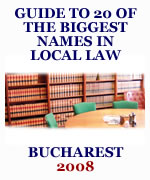Rail vision lacks cash incentive
Romania is a willing partner for harmonisation with the European train network and has the framework for a liberalised train system – but lack of cash is stalling the progress of rail
|
||||||||||||
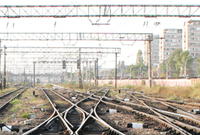 Romanian rail is not in a disaster. Billions may be needed for infrastructure. Railway stations need serious upgrading. New communication systems and electrified lines are necessary. Yet, the country is becoming interoperable with the EU and its investments target the European Corridors that link up with a comprehensive vision for continental transport.
Romanian rail is not in a disaster. Billions may be needed for infrastructure. Railway stations need serious upgrading. New communication systems and electrified lines are necessary. Yet, the country is becoming interoperable with the EU and its investments target the European Corridors that link up with a comprehensive vision for continental transport.
“Romanian Railways are already in the process of harmonising with the EU standards and its eastern neighbours,” says Michael Arshad, senior railway consultant at Louis Berger. “There is a hell of a lot development going on.”
Experts agree that Romania is keen to conform to the EU blueprint for rail transport. “Romania is a model for the countries in the region and the local authority works according to the latest relevant European directives,” says Roxana Lazar, CEO of public finance bank Dexia Kommunalkredit Romania.
But all is not perfect. What is missing is money and the good management of available cash for the maintenance of a vast network and the modernisation of a slow fleet of trains.
Romania needs clear and realistic targets for its rail network. Experts call for greater long-term planning, budgeting and larger scale projects.
“Romania needs to know what it wants its rail network to deliver,” says Michael Robson, secretary general of European Infrastructure Managers.
 Romania’s rail transport may never be a profitable business – but the structure exists for the network to be a partner in the development of the country and a trade link between Asia, Africa and Europe. “But to be an important player, a dramatic modernisation of the infrastructure in speed and signalling is needed,” says Christian Serjannis, head of Siemens’ department for Transport Systems Rolling Stock.
Romania’s rail transport may never be a profitable business – but the structure exists for the network to be a partner in the development of the country and a trade link between Asia, Africa and Europe. “But to be an important player, a dramatic modernisation of the infrastructure in speed and signalling is needed,” says Christian Serjannis, head of Siemens’ department for Transport Systems Rolling Stock.
Crucial link
There are two rail corridors on the Trans-European Networks (TEN) system that include Romania: Corridor IV which passes from the Hungarian border, through Arad and Brasov to Constanta and Corridor IX, which runs north to south, from the Moldovan to the Bulgarian border. The two meet in Bucharest. Corridor IV is the priority because this is the main link from Romania to the EU and between Constanta and Budapest and Vienna.
“We forecast that the economic growth in the southeast European region will lead to a bigger demand for transport in general,” says state secretary in charge of rail infrastructure at the Ministry of Transport, Septimiu Buzasu.
The state secretary says this general economic development will help rail provide better comfort, security and time conditions. “It will become preferable to road transportation,” he adds.
But railways will not be a beneficiary of trickle-down economics – they need active investment and fast.
Structural and cohesion funds are linked to these two corridors – along with pre-accession funds, cash from the European Investment Bank and the Japan Bank for International Corporation. Money is theoretically available.
Poor cousin to road
There is bitterness among rail stakeholders that road transport has taken priority. This is despite the environmentally friendly credentials of trains. “Rail is less polluting than road and it costs less than building highways and one can substantially reduce traffic time,” says Gabriel Stanciu, managing director of Alstom Transport.
The ideal plan would be to place high speed rail networks next to motorways on European transport corridors. “Unfortunately because Romania has only two operational motorways at this moment, all the attention is oriented to the development of this sector,” says Serjannis.
Authorities complain that access to cash is holding back development. Since 2001, Romania has had a strategy for railway modernisation, but has failed to meet its objectives.
“Our plans are extremely beautiful on paper, but cannot be put into practice,” says Buzasu. “We are far from being on schedule because we weren’t given enough money.”
For the time being, Romanian railways are in a bad state and need heavy investment to reach the European level. Around 1.5 billion Euro from the European funds are destined for modernising the railways in the next seven years.
But this may not be enough. “In the next ten years, Romania needs ten billion Euro to finance the modernisation of railway infrastructure,” says Lazar.
In the first nine months of 2007 the Ministry invested only 15 million Euro in modernising and repairing the railways, while rail operator CFR saw a deficit of 74 million Euro in the same period. This loss is scheduled to increase.
But it is not a question of how rail can make money, but how the Government and European funds, as well as loans and credits, can be managed to the greatest degree possible.
There also needs to be a fair distribution of Government cash to rail.
“The Ministry of Transport collects money from all companies it controls and then redistributes it according to needs,” says Lazar. “Of this money, 25 per cent is obtained from fees from other train operators on the rail network, but investments in rail infrastructure stand at only five per cent of this money. The bulk is being used for road rehabilitation, which represents unfair competition and leaves the rail sector behind.”
The railway network needs to operate as a business, even if never expects to make any cash. But transport authority contracts change every year and Romania’s rail network only knows its budget at the beginning of the year. “It can move from feast to famine,” says Robson.
Multi-annual contracts between state and rail infrastructure companies give more stability to financing, argues Robson, which can then be invested in staff and equipment. “You should get a contract with a better price if you know the value will spread over four or five years,” he says. “Long-term planning should drive up quality.”
Private moves
Foreign investors who want to operate on passenger transportation have full access to the Romanian state railway infrastructure. While freight carriers have already taken advantage of this openness, few passenger operators see a solid cash return in taking to the rails.
“Passenger traffic is a public service obligation and unless it is subsidised it will not work,” says Francoise Heidebroek, project management and key expert with Transurb Rail.
Three private companies, RC-CF Trans Brasov, Via Terra Spedition Cluj and Servtrans Invest, are now active in Romania, in the Brasov, Cluj, Sibiu and Timis areas, mostly on non-interoperable railways transporting passengers on short distances. But they are looking to expand to long haul.
Roxana Lazar says four national operators have submitted requests to the Ministry of Transport for international licenses to run in Romania. These are expected to be on the Corridor IV and IX and close to the borders with Serbia and Hungary.
There are currently 30 rail operators, out of which 25 are private operators for freight transport, CFR Marfa, two private operators for people transport, CFR Calatori, Compania pentru Turism Feroviar and the private operator for passengers and freight, Servtrans Invest.
In the future, more private operators could bring much needed investment to the rail network.
“There could be competition on routes between Bucharest and Constanta,” says Michael Robson. Another option would be to privatise a regional service. “Maybe this is a step too far at this stage,” Robson adds.
The privatisation of freight transporter CFR Marfa may turn on new kinds of investors to the potential in Romanian rail – if this ever happens. “Big players from abroad are ready to come with investments and new rolling stock into Romania,” says Serjannis. “The more this process is being delayed the more it will affect the development of the rail infrastructure.”
So far, local private rail freight firm Servtrans is considering entering consortium to bid for the freight transporter. Deutsche Bahn could also be a contender, predict some experts. Servtrans has estimated the company to be worth around two billion Euro.
While passenger transport for short distances will always make a loss, long distance can turn a profit. Buzasu says the solution is to split the activity of state passenger operator CFR Calatori into two: profitable long-haul, which can then fund the loss-making short-haul. “We have to give the profitable activity the chance to further develop based on proper and professional management,” says the state secretary. “The other type of passenger transportation will have the chance to improve and become attractive thanks to subsidies.”
Another cash generator could be using transport hubs, such as turning train stations into modern centres of retail, business and communication. These can be potential moneyspinners for station operators and encourage rail use. The modernisation of Bucharest’s terminus Gara de Nord could use a public-private partnership.
“The public budget would finance rail rehabilitation, while private money could fund the establishment of shopping areas,” says Heidebroek. “Now Gara de Nord sees lots of different development projects pushed by real estate developers. Unfortunately, there is no practical solution for transport in these plans.”
In the neighbourhood
Now locomotives have to change at a great number of the EU’s borders. There are also different signalling systems and power intensities on the electric lines between Romania and its neighbours, especially to the east. Part of Europe’s plan is to encourage states to introduce a consistency across this infrastructure to ensure interoperability between member states. Romania is upgrading its signalling system European Rail Traffic Management System (ERTMS) on the two transport corridors to conform to the European standard, while its power supply system is in keeping with EU norms.
There is also a move to more global interoperability. A China to Europe rail corridor, probably through the Ukraine and Slovakia, is a future plan to increase freight between the east and west. “We cannot deal with everything going by ship or road,” says Robson. “Road, rail, water and sea all have a role to play.”
Need for speed
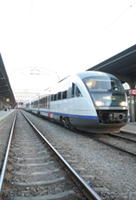 The Ministry of Transport is now modernising the system so that passenger trains can run at 160 km per hour and freight trains at 120 km per hour – but there is no deadline for when this will be ready.
The Ministry of Transport is now modernising the system so that passenger trains can run at 160 km per hour and freight trains at 120 km per hour – but there is no deadline for when this will be ready.
In the meantime, the Government is enthusiastic about high speed rails as an alternative to air travel. “They’re less expensive, it takes the passengers to the middle of the town and it is much more comfortable,” says Buzasu. But he says that not until 2017 could Romania offer such an alternative to its citizens.
High speed rail needs a speed of over 300 km/hour. There must be an hour between stations. This means that Romania’s potentially most profitable line, Constanta-Bucharest, may be too short a distance for high-speed rail alone. Integration is needed.
Recently, the Minister of Transport, Ludovic Orban, started discussions with European partners for Romania to be among countries to introduce a railway for high speed trains from Paris, through Munich, Vienna, Budapest and Bucharest to Constanta. There is also talk of high speed rails connecting Bucharest and Sofia.
In Romania, Carlos Leon Galvez, branch manager at Inocsa says that it should be necessary for railway lines over 400 km. This includes Bucharest to Cluj-Napoca, Timisoara and Iasi.
“In Spain the most profitable lines correspond with the high speed lines such as Madrid - Seville or (as yet uncompleted) Madrid - Barcelona,” says Galvez.
Everyone wants to see a TGV running from Bucharest to Budapest, but achievable goals are necessary for the next five years – such as adequately fast Intercity trains. Passenger trains need to run with a 250 km/h speed and freight trains at a 120 km/h speed, up from 80km/h now. “Before World War I, one could travel from Bucharest to Arad in just five hours,” says Stanciu. “Now it takes seven hours to get to Deva, which is just over halfway to Arad, by Intercity train.”
| Big network, slow trains |
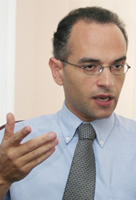 Romania is both the seventh largest country in the EU in terms of population and the length of its railway network, 11,000 km. The country is well connected, but the numbers of passengers using railways has dropped and 3,000 km of railways are not used by the main operator, Romanian National Company for Railways (CFR), which has leased one third of these lines (1,000 km) to private companies. Romania is both the seventh largest country in the EU in terms of population and the length of its railway network, 11,000 km. The country is well connected, but the numbers of passengers using railways has dropped and 3,000 km of railways are not used by the main operator, Romanian National Company for Railways (CFR), which has leased one third of these lines (1,000 km) to private companies. Trains move slowly and on some lines are travelling at only 40 km/hour. “Operators using the Romanian rail infrastructure have to roll with reduced speed due to the poor state of the infrastructure,” says Roxana Lazar, Dexia Kommunalkredit. “Freight trains have to stay up to eight hours in yards due to crowded traffic.” “These things take time but great strides are being made by the government and the rail operators,” says Chris Germanacos, director for Europe and senior vice president of Louis Berger, which is working on improving the General Transport Masterplan. But improvements are ongoing along the transport corridors. Francoise Heidebroek, project management and key expert with Transurb Rail, cites how works on the Bucharest - Campina section of Corridor IV have completed in the deadline and on budget. The firm is now working on the Campina – Predeal section. “This is the most difficult part of the entire corridor, because it passes through the mountains at a 1,200 m high altitude,” she says. |
Battle over city transport
Metro expansion is a necessity for the city – but there is a fight over who should own the underground
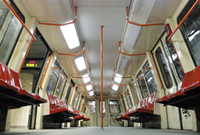 As the traffic in the city comes to gridlock, more commuters are ducking into the Bucharest Metro as the only mode of transport where they can be assured of the length of journey time.
As the traffic in the city comes to gridlock, more commuters are ducking into the Bucharest Metro as the only mode of transport where they can be assured of the length of journey time.
The underground now clocks up around 650,000 journeys during the weekdays and this is set to rise as Bucharest grows and more people use the Metro at the expense of private cars and overland transport.
The Metro operator, Metrorex, says it plans to open up new lines from current four to eight and increase the number of stations on existing lines.
But critics have argued that their strategy lacks coordination with the city planning.
“The Metro expansion strategy is built on illusions,” says Gheorghe Udriste, general director of the Infrastructure and Public Services General Department, Bucharest City Hall. He argues that the Metro’s development strategy must be integrated with the plans of Bucharest City Hall and its overground public transport system. At present the Metro and its operator Metrorex are only answerable to the central Government, the Ministry of Transport.
“[Metrorex] has not been managed properly for the past seven years and any decision they have taken so far has been done without consultation with Bucharest City Hall,” says Udriste. “A minister cannot coordinate transport in a city alone. He has other problems and Metro expansion is not a priority for him, because, as proof, nothing has been done.”
Therefore, Bucharest’s general council wants to establish a Metropolitan Transport Authority uniting trams, buses, trolleybuses and metro, under the control of the Bucharest City Hall.
But this needs approval from the Ministry of Transport, which may not want to give up the Metro.
“I don’t think Metrorex should come under the responsibility of the Bucharest City Hall because the Ministry has the capacity to attract more money,” argues Gabriel Stanciu, managing director of Alstom Transport Romania. “The ministry gets its budget from taxes from the entire population of Romania, while the Bucharest City Hall only gets its funds from the capital. And nobody said metro transportation should be a profitable business.”
Bucharest Metro: Plans going ahead
Bucharest Metro travellers |
|
| 2003 | 102.3 million |
| 2004 | 108.2 million |
| 2005 | 116.1 million |
| 2006 | 138.7 million |
| 2007 forecast | 168.7 million |
In the east
The east of Bucharest’s Metro on the M1 line, started in 1989 but delayed due to the reconstruction of the country, will see the four-station, 4.5 km long extension to connect Nicolae Grigorescu with the ring-road and the Bucharest-Constanta motorway, open in the second half of 2008. “Now low voltage electrical installations are being installed and public spaces have been completed,” says Stefan Rotaru, technical and investment director at Metrorex.
The 12-year project costs 76 million Euro and uses 38 million Euro funds from the European Investment Bank (EIB) and the remainder from the Romanian Government.
In the north
The Metro’s extension to the north-west has also seen delays – but is moving. “We are now finishing structural works on the 1 Mai - Bazilescu line, between Pajura and Parc Bazilescu,” says Rotaru. This work aims to finish in the second quarter of 2008. This 55 million Euro project has received 30 million Euro financing from the EIB for structural works. It needs a further 25 million Euro is for equipment and operation from the public budget.
To the airport
Bucharest’s General Council has approved the plan to build a Metro line to link the city centre with Henri Coanda airport in Otopeni. This will not be an investment by Bucharest’s underground operator Metrorex, although the transport company will operate the line, although it is not under the control of Bucharest City Hall. The 1.1 billion Euro project will be financed 80 per cent by the Japan Bank of International Cooperation (JBIC) in a ten-year grace period that has to be repaid in 30 years with interest standing at 1.5 per cent.
Not everyone agrees with the plan. “It will not be profitable and cannot become profitable,” says Stanciu. “Much more simple is a rail link between Gara de Nord and Otopeni, which is cheaper, because the rail is already in place.” The new line to Otopeni will depart from Piata Victoriei and will include Blvd Expozititei and Baneasa Airport. This approach will also allow for further development of a North-South line, between Uranus and Progresul in the southwest.
This line will have 19 stations, one depot and will be served by 20 trains, transporting about 50,000 travellers per hour for 16 km. Its completion deadline is between five and seven years – at the earliest 2013. “The line will be completely underground,” says Udriste. “There were some ideas to have it over the ground, but they were stated without consulting the existing urban context and realising the real problems of going through some plots of land.”
Travelling time from Piata Victoriei to Otopeni will last a maximum of 30 minutes.
Bucharest Metro:
What might happen, but isn’t definite
Central
Both Metrorex and Bucharest central authorities say the “priority” project is the new M5 line, linking Drumul Taberei to Pantelimon. A feasibility study on the first nine km phase, from Ghencea-Drumul Taberei-Razoare-Eroilor-Universitate is complete.
This will have 13 stations and need 570 million Euro, including 21 new trains. “The project will start operating seven years after we begin works, which means 2015 if we begin now,” says Rotaru. “EIB has agreed to finance the M5 line and we are now waiting for the Ministry of Finance to approve the credit.”
There is also a feasibility study for the second phase, from Universitate to Pantelimon. This will be eight-km long with 13 stations, costing 828 million Euro including 15 trains, with a five year period of development. There is as yet no financing for this line.
Southwest
The south-west lacks exposure to a Metro, but that could change with the plan to build a southern arc between the west at Crangasi to Dristor 2 in the east. This line will also include stations at Armata Poporului, Ghencea, Rahova, Toporasi, Piata Sudului and Splaiul Unirii. The southern arc will be 16.5 km long and will have 25 stations, with a total investment of 741 million Euro.
New lines
Besides M5, Metrorex has also commissioned the feasibility studies for two more projects. There is the extension of the M4 line, from Gara de Nord to Progresul, costing 550 million Euro, 10.7 km in length with 20 stations. Also the 924 million Euro diagonal M7, 21 km in length with 31 stations, from the southwest Rahova to northeast Colentina.
More stations
Besides these projects, there is a 225 million Euro investment plan to build nine stations on the existing lines. These include Dorobanti, Colentina Hospital, Maior Coravu, Calea Vitan, Pod Marasesti, Budapesta, Podul Grant, Liviu Rebreanu and the Polytechnic Institute.
Trams: travellers leaving for Metro
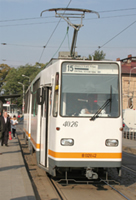 Bucharest’s tram network has seen a drop in the number of users this year. The capital’s public transport authority RATB has reported 197 million journeys by tram in the first six months of 2007, down from 202 million journeys for the same period in 2006.
Bucharest’s tram network has seen a drop in the number of users this year. The capital’s public transport authority RATB has reported 197 million journeys by tram in the first six months of 2007, down from 202 million journeys for the same period in 2006.
“There is a migration from RATB travellers towards Metro,” says RATB exploitation director Valeriu Bunea. “Reasons include the climate, the traffic and the roadworks which are making over the ground travelling harder.”
Bucharest’s 280 km tram network is now undergoing a large modernisation programme. Most infrastructure experts highlight the importance of separating the tram network from the car traffic to ease congestion and improve efficiency, which is happening on some lines. But on other lines which are not in use or are sidelined for redevelopment, vehicle owners are using the railways as an improvised car park in the centre of the road.
“Tram lines have all the chances to follow the city’s development,” says Gabriel Stanciu, Alstom Transport. “If I were in charge, I would build metro lines in crowded areas and tram lines on the outskirts.”
But there are no plans to build any new lines or remove any old ones. “Expansion meets reluctance from Bucharest inhabitants who live close to tram lines, as well as from car drivers,” says Bunea. “Those who live on streets with tram lines complain about the noise, while drivers complain they do not have a place to drive. This problem is mainly connected to the current configuration of streets in Bucharest and that some lines are superimposed on metro lines. In Bucharest, metro expansion is more feasible.”
By Corina Mica,
Michael Bird and Ana Maria Nitoi




